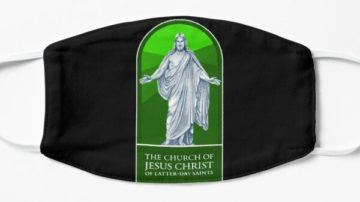by Akim Reinhardt
 There’s a lot we can learn about today’s America by observing the Mormon Church.
There’s a lot we can learn about today’s America by observing the Mormon Church.
Last month the Church of Latter Day Saints, as its officially known, issued a strong, positive directive to its 16.5 million members. Vaccines had been proven safe and effective, it reminded them. And please wear a mask in public gatherings, it implored them. The statement’s language was uplifting and unifying: “We can win this war if everyone will follow the wise and thoughtful recommendations of medical experts and government leaders,”
It led to a backlash.
Despite this urging from the LDS’ top ranks, nearly a fifth of church members say they will not get vaccinated. Another 15% are hesitant. Some anti-vax and anti-mask members complain the church is restricting their freedoms. In response, some Mormon vaccination and mask supporters are accusing the mask and vaccine holdouts of apostasy. Even bishops (regional church leaders) are divided. In one Idaho church, bishops stood in front of their congregation unmasked to read the official proclamation encouraging masks.
The Church of Latter Day Saints has one of the most loyal constituencies of any large social organization in America. There is no unanimity of course; small splinter groups have always existed, and as with any religion, some people are always distancing themselves from the church or leaving it altogether. Nonetheless, for two centuries practicing Mormons have been bound together by faith; a history of persecution; geography; relative cultural homogeneity here in the U.S.; a rigorous schedule of activities in the home, at church, and elsewhere, all designed to reinforce membership and belonging; and by a highly organized, hierarchical, patriarchal, and doctrinaire leadership that has wielded tremendous influence over its loyal followers, who typically follow specific dictates such as no alcohol, coffee, or tea.
So if even the Mormon Church is having trouble getting its truehearted constituents to follow simple health directives overwhelmingly backed by science and designed for their own benefit, then you know this about something much bigger than masks and shots. This is about what has happened in America during the last four decades. Read more »

 Most people associate the Cold War with several decades of intense political and economic competition between the United States and Soviet Union. A constant back and forth punctuated by dramatic moments such as the Berlin Airlift, the Berlin Wall, the arms race, the space race, the Bay of Pigs, the Cuban Missile Crisis, Nixon’s visit to China, the Olympic boycotts, “Mr. Gorbachev, tear down this wall!” and eventually the collapse of the Soviet system.
Most people associate the Cold War with several decades of intense political and economic competition between the United States and Soviet Union. A constant back and forth punctuated by dramatic moments such as the Berlin Airlift, the Berlin Wall, the arms race, the space race, the Bay of Pigs, the Cuban Missile Crisis, Nixon’s visit to China, the Olympic boycotts, “Mr. Gorbachev, tear down this wall!” and eventually the collapse of the Soviet system.